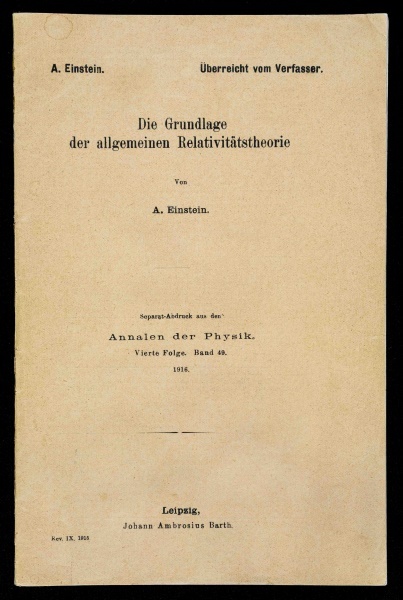Einstein: ‘The Foundation of the General Theory of Relativity’
There is a constant dual theme in the development of cosmological theories—description of observed phenomena on the one hand, and a deeper explanation of those phenomena on the other. Aristotle had a fairly complete physics of why nature behaved the way it did; for most modern scientists, a great deal of his work is “wrong,” but this is mainly because our standards of explanation seem to have changed.
The conflicts between Galileo and Kepler show one aspect of this: the former insisted that circular heliocentric orbits must be the fundamental structure of the heavens, whereas the latter started with the Platonic solids as the basis for explaining why planets were arranged as observed. As Kepler developed his planetary laws, including the use of elliptical orbits, there was still no understanding of why this might be so. A century later, Newton formulated mathematical (not just geometric) laws of motion and of gravity linking the behavior of objects on earth with the motions of the planets in the sky—a truly remarkable achievement.
However, there was still the matter of “how”—Newton’s Law of Gravitation beautifully describes the forces acting between any two massive objects. After all, Newton said that two objects would attract one another with a force proportional to their masses and inversely proportional to the square of the distance between them. But that means that they pull on each other without being in contact in any way. How can one object even “know” that the other one is out there?
Einstein started with considerations of objects moving at constant speed close to the speed of light. Special relativity theory (one part of the output of his miraculous year 1905) is just that—a special case, for objects not undergoing acceleration, of a more general theory. One of the major conceptual consequences of the special theory of relativity is the intermingling of space and time as one unified geometric entity.
When turning to considerations of accelerating objects, the subject of The Foundation of the General Theory of Relativity, a simple question that can be asked is the following: When you accelerate upward (for example in an elevator), you momentarily feel heavier; if one did not know better, one might assume that instead of being accelerated by the elevator, someone playing a practical joke had decided to move another planet into place underneath your unmoving elevator cabin. In any case, the net result would have been the same—you would feel heavier, now due to the increased gravitational force. Einstein postulated a new geometrical interpretation of spacetime; in contrast to Newton, for whom gravitational motions are due to the properties of the massive bodies, general relativity tells us that what we interpret as gravitational forces are really due to curvatures of a spacetime manifold. The easiest way to think about this is to imagine a rubber sheet with heavy objects sitting on it. A rolling marble will be diverted from a straight-line trajectory if it comes within range of the curvature of the rubber sheet. The marble will follow a deflected path, but in the unified spacetime, this will be the shortest path, rather than the straight line we would normally expect.
These thought experiments of Einstein’s (for special relativity, he imagined what he would see if riding on a wave moving at the speed of light) were revolutionary, but a bit too strange for mainstream science. He won his Nobel Prize not for this, but for a second piece of work from 1905 on the photoelectric effect.
In the end, his work brings us back full circle to Ptolemy and the heliocentric followers, as well as to Galileo and Kepler. Geometry, now understood in a more general way, is language of the universe, as Galileo and Kepler believed. And in the end, it is not simply that the earth revolves around the sun, but rather that the earth, sun, planets, and stars are all taking part in a complex cosmic dance, with no one participant being inherently more important than the others.
Or perhaps it has all been a drive toward smartphones and tablet computers. After all, one of the common applications of Einstein’s general theory of relativity is in making corrections to measurements made by satellites orbiting the earth as part of the global positioning system (GPS). To determine the location of a person holding a GPS unit (like in most phones) to within a few meters, Newton’s theory of gravitation would not be sufficient. It is necessary to take into account effects nobody knew about until 1915; without these corrections, the locational accuracy of a GPS unit would be useless within a few minutes or less.
—Robert Brecha, PhD, Professor, Physics
Robert Brecha, professor of physics, describes Albert Einstein's motives for examining gravity and the development of his general theory of relativity. Interview is an online supplement to the University of Dayton exhibit Imprints and Impressions: Milestones in Human Progress—Highlights from the Rose Rare Book Collection, held Sept. 29 through Nov. 9, 2014.

